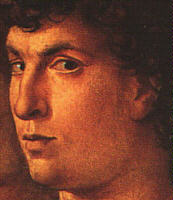
GIOVANNI
BELLINI, like his brother Gentile Bellini,
began his career as an assistant in the studio of his father, Jacopo
Bellini (c. 1400-70). His early work, executed in tempera, reflected
a confluence of Byzantine stiffness and the analytical precision of
the Flemish. Soon Bellini trained himself to become one of the early
masters in the techniques of oil painting. He was later influenced by
Donatello (to whose works he was exposed while executing with his father
and brother the Pala Gattamelata for the Church of Sant'Antonio da Padova)
and by the work of his sister's husband, Andrea
Mantegna.
By
1479 Bellini had succeeded his brother in executing a cycle of great
historical scenes for the Chamber of the Grand Council [Maggior Consiglio]
in the Doge's Palace. Giovanni Bellini's six or seven canvases in the
series, acclaimed as among his masterpieces, were destroyed in the devastating
Palace fire of 1577.
The
theme of Madonna and Child recurs frequently in Bellini's work. Mariolina
Olivari comments in Giovanni Bellini [p. 4], "Bellini's paintings
are characterized by a strange, subtle tension that always binds the
mother and child in a relationship of profound pathos." One of Bellini's
most masterful works is the Madonna and Child enthroned with SS.
Peter, Catherine, Luisa and Jerome, painted in 1505 when he was
approximately 75 years old. The painting is in the Church of S. Zaccaria.
Bellini's late work, however, is characterized by highly naturalistic
landscapes.
In
1506 Bellini's brother-in-law Andrea Mantegna died after completing
only one of a cycle of four paintings commissioned by Cav.
Proc. (later Cardinal) Francesco Cornaro (B-60). Thereupon, Cornaro
turned to Bellini to execute, with his studio, The
Continence of Scipio, perhaps based on a drawing by Mantegna.
(See P. F. Brown, Venice and Antiquity [New Haven, 1996], pp.
252-5.) The painter and art historian Giorgio
Vasari noted in 1568 that Giorgio Cornaro
(presum. H-4, the nephew of Cardinal Cav. Proc. Francesco) had in his
collection at that time another of Giovanni Bellini's paintings, Cena
at Emaus; that work, although recorded in an engraving and several
derivations by another artist, has not survived.
In
The Uffizi: A Guide to the Gallery [Venice: Edizione Storti,
1980, p. 60] Umberto Fortis has noted that "Bellini with his absorption
of the achievements of the greatest masters of the age traces the development
of Venetian Humanism itself in his own evolution as a painter, to attain
a superior, serene autonomy of compositional values."
Bellini
trained many younger artists in his workshop, including Giorgione,
Titian, Jacopo da Montagna, Rondinello da Ravenna and Benedetto Coda
of Ferrara. He was recognized in his own time as the leading painter
of his period. Upon visiting Venice in 1506, the German artist Albrecht
Durer wrote: "He is the best painter of them all." The prominent
writers of his time also joined in his praise, including Pietro Bembo
in his verses and Ariosto in Orlando Furioso, Canto 33. In
Vasari's words, "There is no lack at Venice of those who endeavored
to honor him when dead with sonnets and epigrams, just as he had honored
his country when alive."


